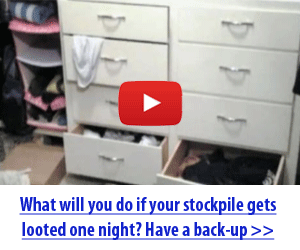Why Every Prepper Should Grow a Survival Garden
When it comes to prepping, food should be at (or near) the top of the list. While stockpiling all your food might seem feasible in the movies, it’s not realistic long-term. It is expensive, unhealthy, and in some cases, just not possible. Canned, freeze-dried, or dehydrated—all food expires at some point.
That’s why every prepper needs to learn how to grow a survival garden. Whether you live in a rural area, the suburbs, or the city, growing your own food is a reality. It’s a healthy and sustainable option to supplement your survival food stockpile. Plus, it can benefit you now with fresh produce, herbs, and medicinal plants, even if you’re not into prepping.
Growing an Indoor Garden vs. Growing an Outdoor Garden
Growing plants outside is of course the more natural choice, but sometimes nature gets out of hand. Windy days can knock down plants. Intense sunlight can burn leaves. Heavy rain can overwater and wash away essential nutrients in the soil. Your plants are also susceptible to pests when left outdoors.
When Growing Outdoors isn’t an Option
If you live in an urban area, you may not have access to an outdoor area to start a garden. It’s also possible that you live in an area where harsh winter nights or hot summer days will damage plants left outside. And if invasive pests take over the world (like the Spotted Lanternfly has in PA), you’ll want to be sure your plants are protected indoors.
However, growing outdoors isn’t a bad idea. Outside, you get natural sunlight, rainwater, and essential nutrients from soil if you live in a healthy environment. Your situation can help you decide whether growing outdoors or indoors is best for you.
The Unique Challenges to Gardening Indoors
Growing an indoor survival garden presents its own challenges, too. If your gardening space doesn’t have enough natural or artificial sunlight, your options for growing indoors may be limited.
The area near your windows can overheat and burn plants if you’re not careful. Since your plants will be potted, overwatering and root rot are common problems to watch out for. Gardening indoors isn’t necessarily the better choice for everyone, but it may be for you.
9 Essential Tools for Growing an Indoor Survival Garden
Before we get started, you’ll need a few gardening tools.
Shelving
To maximize your space, you’ll want to think vertically. Consider where you can put multi-tiered shelves in your home and utilize your window sills if you have any.
Artificial Light
Most people don’t have enough natural light to sustain an indoor survival garden, so the chances you’ll need to supplement with artificial light are high. Instead of purchasing expensive grow lights, you can put LED bulbs in regular light fixtures. Make sure you choose a bulb with a Kelvin rating between 5k to 6k that puts out at least 2,500 lumens. You’ll want to have your grow lights on for 12 hours a day.
Different Sized Planters with Good Drainage
Whether you choose to grow large or small scale, you’re going to need various containers to house your precious plants. No matter what, make sure your plants grow in a container with excellent drainage. Wet soil is an invitation for root rot that can kill your plants at their roots.A Gentle Breeze (A Fan)
Plants thrive with proper airflow. To mimic the airflow that they benefit from outdoors, run a small fan to circulate the oxygen and carbon dioxide in the air.
Fertilizer
Just like humans, plants need water, a safe place to live, and food. You should “feed” your plants with fertilizer—but every plant will like different food. Household compost is a great way to nourish your plants, and you can also create your own fertilizer from common waste like eggshells, banana peels, and coffee grounds.Scissors or Loppers
You’ll need something to help you harvest your resources. Plus, in an apocalypse scenario, they could be a convenient weapon.
Gardening Gloves
While these aren’t essential, they’ll help you keep dirt out from under your fingernails—and preserve hand-washing water when SHTF.
Spade
A spade is like a mini shovel. This will come in handy during a transplant.
Thermometer
Temperature plays a significant role in whether your plants germinate, grow, and fruit. Make sure your indoor survival garden is at the optimal temperature for your plants.
Planning Your Indoor Survival Garden
Now that you know what tools you need to get started, you can decide what you want to grow (and eat). Some plants are easier to grow and take care of than others, producing more edible fruits and greens year-round—this is what we’ll focus on.
There are countless edible plant varieties for preppers to grow indoors. When choosing your food supply, be sure to pick items you and your family will eat and enjoy.
The best place to start is to let your space determine what types of food you’ll grow and where. Consider, do you have limited, moderate, or serious space available for your indoor survival garden?
Limited Space: Planting a Small Garden in Your Apartment
If you have to be picky about what you grow, choose these nine plants (or as many as you can from each category).
These plants have a long productive lifespan and are versatile in the kitchen. Keep in mind that they will need plenty of light, and the ideal growing temperature for all three is between 70-75 degrees Fahrenheit.
- Tomatoes
- Bell Peppers
- Cucumbers
These crops will produce reliable greens that you can harvest daily. Cut off leaves from the plant’s outer edges about an inch above the stem’s base, never removing over 1/3 of the entire plant.
- Lettuce
- Spinach
- Arugula
You’ll also want to include some herbs and medicinal plants in your garden. These are versatile, edible, and have health benefits.
- Basil
- Aloe Vera
- Lavender
Moderate Space: Devoting an Area of Your House to Your Garden
If you can plant all of the above and more in your indoor garden, here’s what you should grow next.
The essential veggies above are delicious and nutritious, but your family might want more – and something sweeter.
- Sprouts
- Blueberries
- Sweet Potatoes (and their edible leaves)
- Broccoli
If you can, add a few more medicinal herbs.
- Thyme
- Mint
- Chives
Serious Space: Using a Greenhouse, Barn, or Basement
If you have the space to grow a large-scale indoor survival garden, you should produce all of the above and consider what trees you can sustain as well.
You can get more creative with the fruits and veggies you choose to grow and grow some trees if you have the space for them. Keep in mind that they’ll need a lot of artificial light if you’re growing indoors in an area like a barn or a basement.
- Radishes
- Strawberries
- Dwarf lemon tree
- Dwarf peach tree
- Figs
- Mulberries
If you have the room, add a few more medicinal herbs and other plants for air purification.
- Oregano
- Dandelion
- Chrysanthemum
- Peace Lily
Go Grow Your Indoor Survival Garden and Keep Learning!
An indoor garden will help you achieve your off-grid dreams with a self-sufficient food supply—and it can make your life easier when SHTF. But before you plant your indoor survival garden, be sure to do your research about the specific plant varieties you’ve bought.
For a thriving indoor garden, be sure to know your plants’:
- life cycle
- ideal temperature
- watering schedule
- fertilizer needs
- lighting needs
- anticipated production
It’s never too late to learn (until it is).










